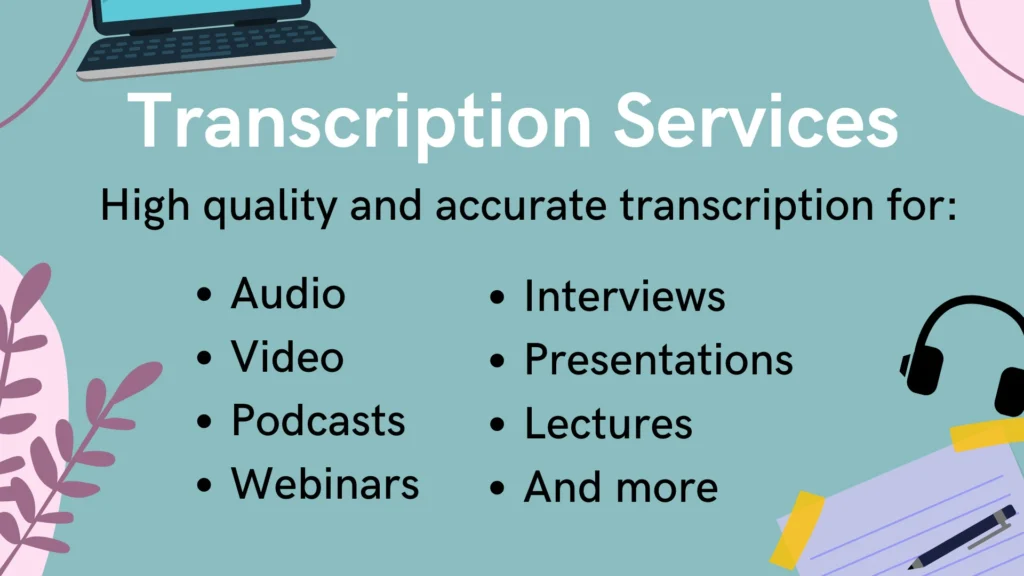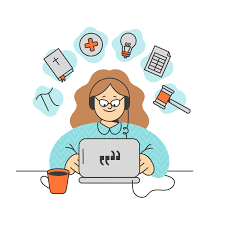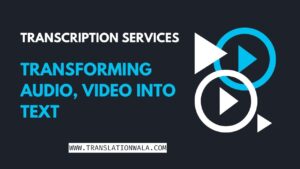The process of translating audio or video content into text is known as transcription. This can be done either manually by a human transcriber or automatically by machine transcription software.
Transcription is used in a variety of industries, including:
- Media and entertainment: To make transcripts of audio and video content such as TV shows, movies, podcasts, and other audio and video content
- Legal: To record court proceedings, depositions, and other legal processes
- Medical: To make transcripts of medical records, doctor’s appointments, and other audio and video content connected to medicine
- Education: To make audio and video transcripts of lectures, seminars, and other instructional audio and video content
- Business: To write transcripts of meetings, conference calls, and other audio and video content linked to business
Also Read: How To Grow Business In India With Language Translation?

Types of Transcription
There are two main types of transcription: verbatim and non-verbatim.
Verbatim transcription is the process of converting an audio or video recording into a word-for-word transcript. This includes any filler words like “um” and “like,” as well as any errors or repetitions made by the speaker. In legal and medical settings, when accuracy is critical, verbatim transcription is frequently employed.
Non-verbatim transcription is the process of producing a transcript of an audio or video recording that catches the key ideas but does not include every single word stated. Non-verbatim transcription is frequently employed in the media and entertainment industries, where it is more necessary to make a readable and entertaining transcript than to have an entirely accurate record of the speaker’s words.
In addition to verbatim and non-verbatim transcription, there are also a number of other specialized types of transcription, such as:
- Medical transcription: This form of transcription specializes in medical records, doctor’s appointments, and other audio and video content linked to medicine. Medical transcriptionists must be well-versed in medical language and processes in order to create reliable transcripts.
- Legal transcription: This transcription service specializes in court transcripts, depositions, and other legal proceedings. Legal transcriptionists must be well-versed in legal vocabulary and procedures in order to create reliable transcripts.
- Academic transcription: This transcription service specializes in the transcription of lectures, seminars, and other instructional audio and video content. To generate reliable transcripts, academic transcriptionists must have a thorough comprehension of the subject matter being discussed.
- Business transcription: This form of transcription specializes in transcribing meetings, conference calls, and other audio and video content connected to business. To produce reliable transcripts, business transcriptionists must have a thorough understanding of business vocabulary and concepts.
Also Read: Unlocking the Indian Market with English to Marathi Translation

How to Choose the Right Type of Transcription for Your Needs
It is critical to consider your needs and budget while selecting a type of transcribing. Verbatim transcription is the best option if you need a perfectly accurate record of what is spoken. However, if you are on a low budget or require an easy-to-read and understand transcript, non-verbatim transcription may be a better option.
It is always better to speak with a professional transcriptionist if you are unsure which type of transcribe is ideal for you. They can assist you in determining your requirements and selecting the appropriate type of transcribing for your job.
Benefits of Transcription
Transcription offers a number of benefits, including:
- Accessibility: Transcription can help people who are deaf or hard of hearing access audio and visual content.
- Accuracy: Transcription can create a textual record of audio and video content for reference or to create searchable archives.
- Efficiency: Transcription can help users save time and enhance efficiency by letting them to swiftly browse and review written content rather than listening to or watching audio or video content.
- Engagement: By giving a written record of what is said, transcription can make audio and video content more interesting and easier to understand.
Conclusion
Transcription is a useful tool that can be applied in a variety of situations. Understanding the various forms of transcription and the benefits they provide allows you to select the best type of transcription for your needs and budget.



